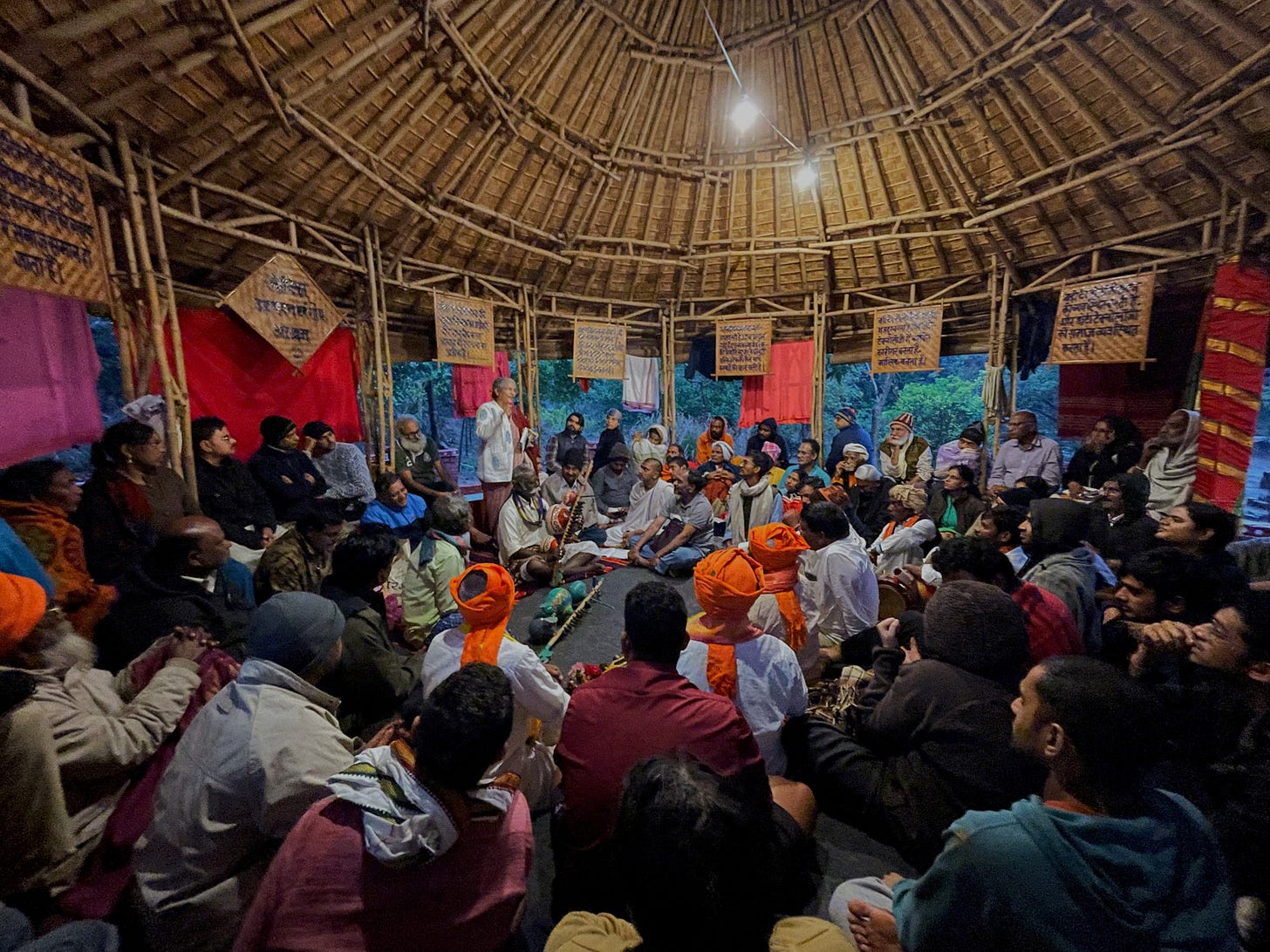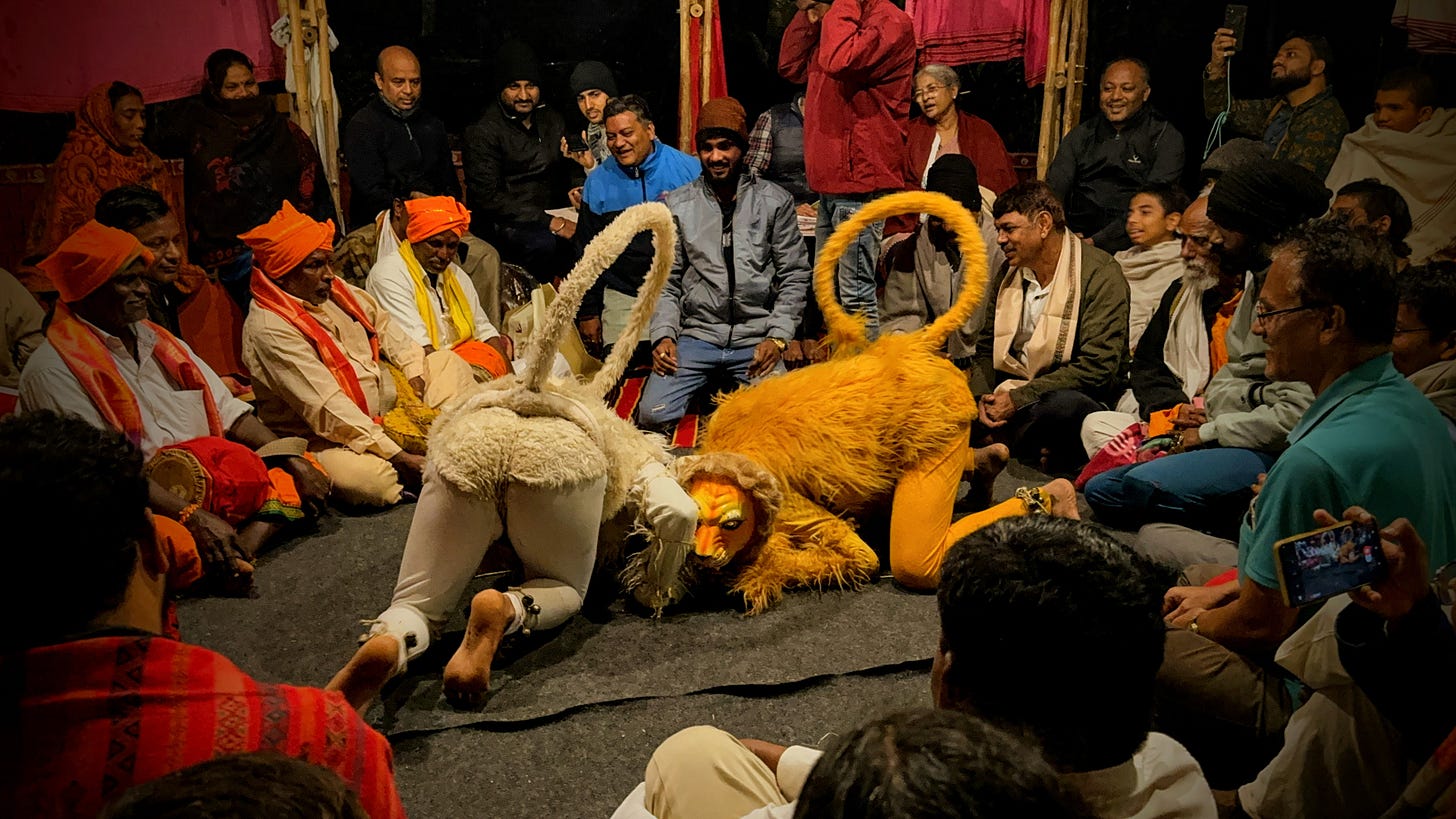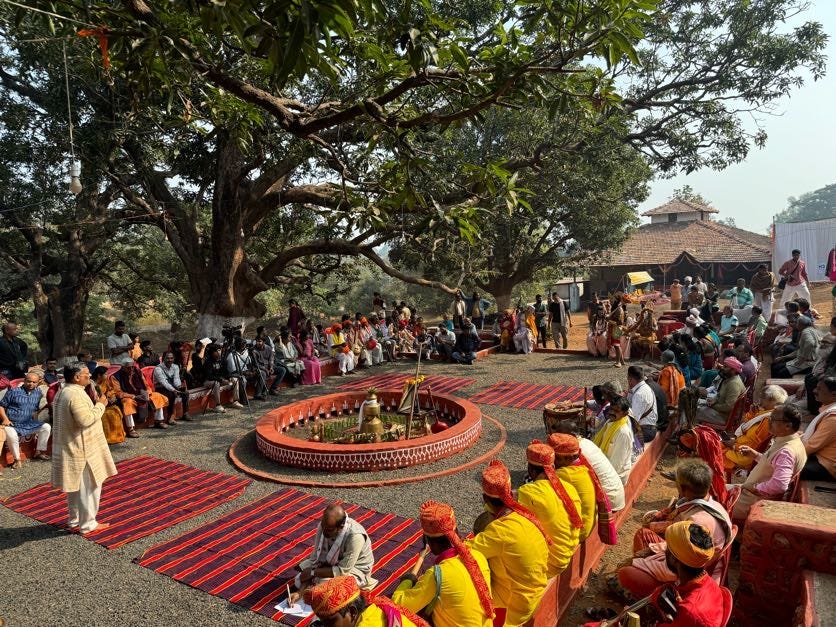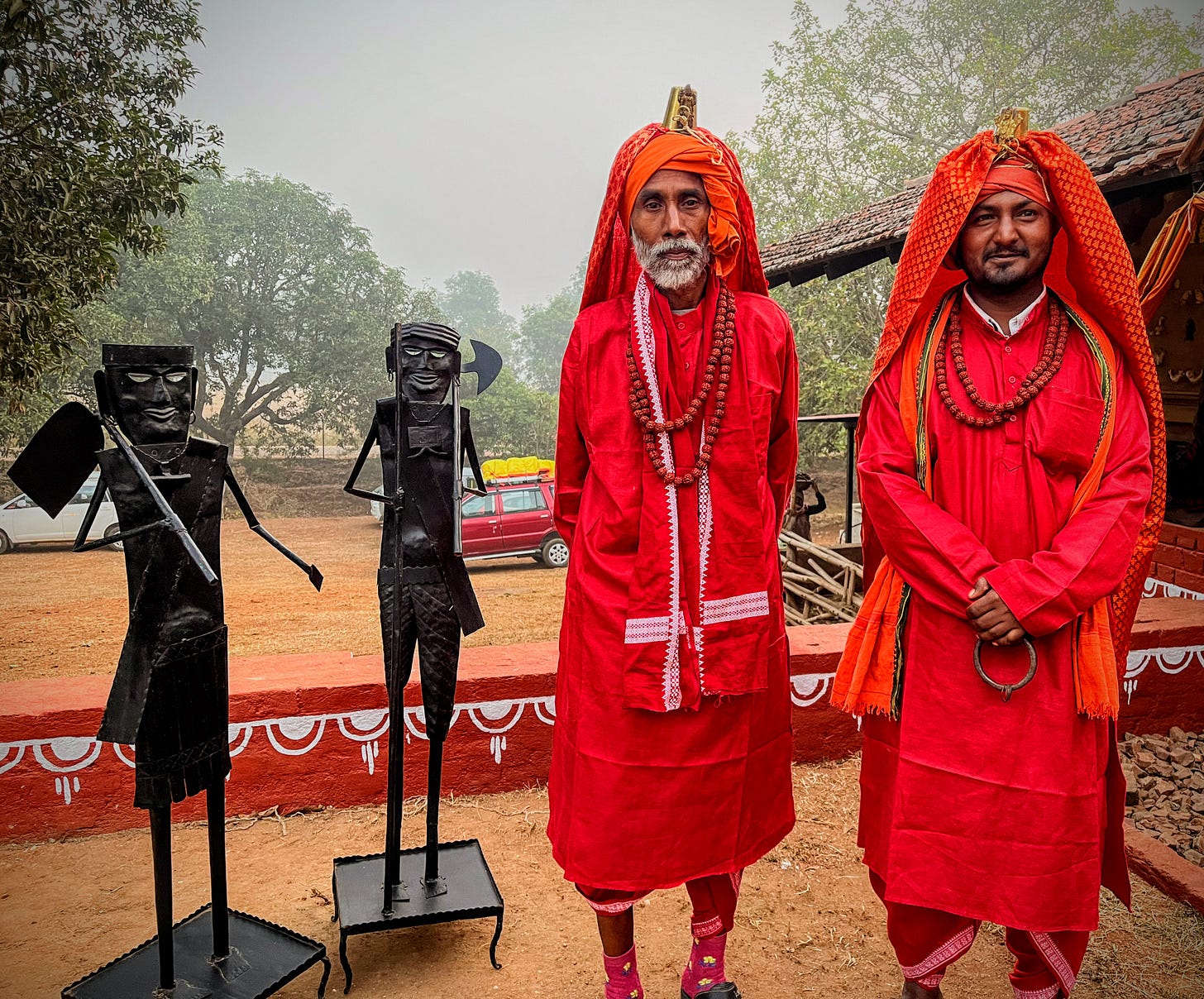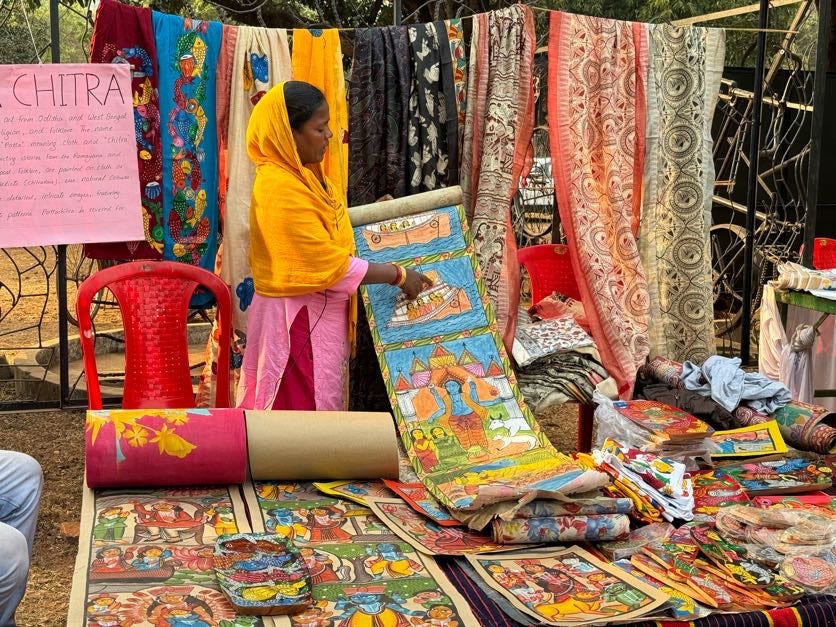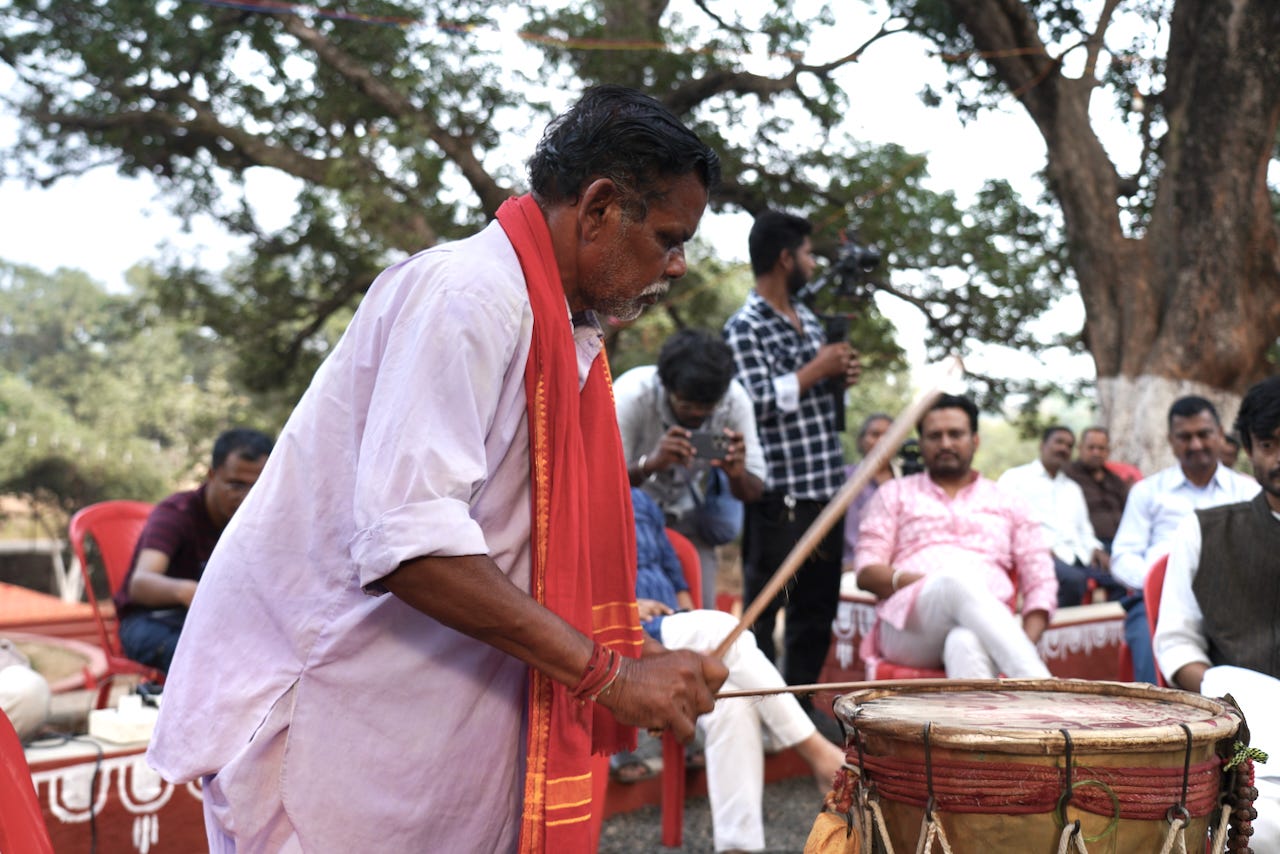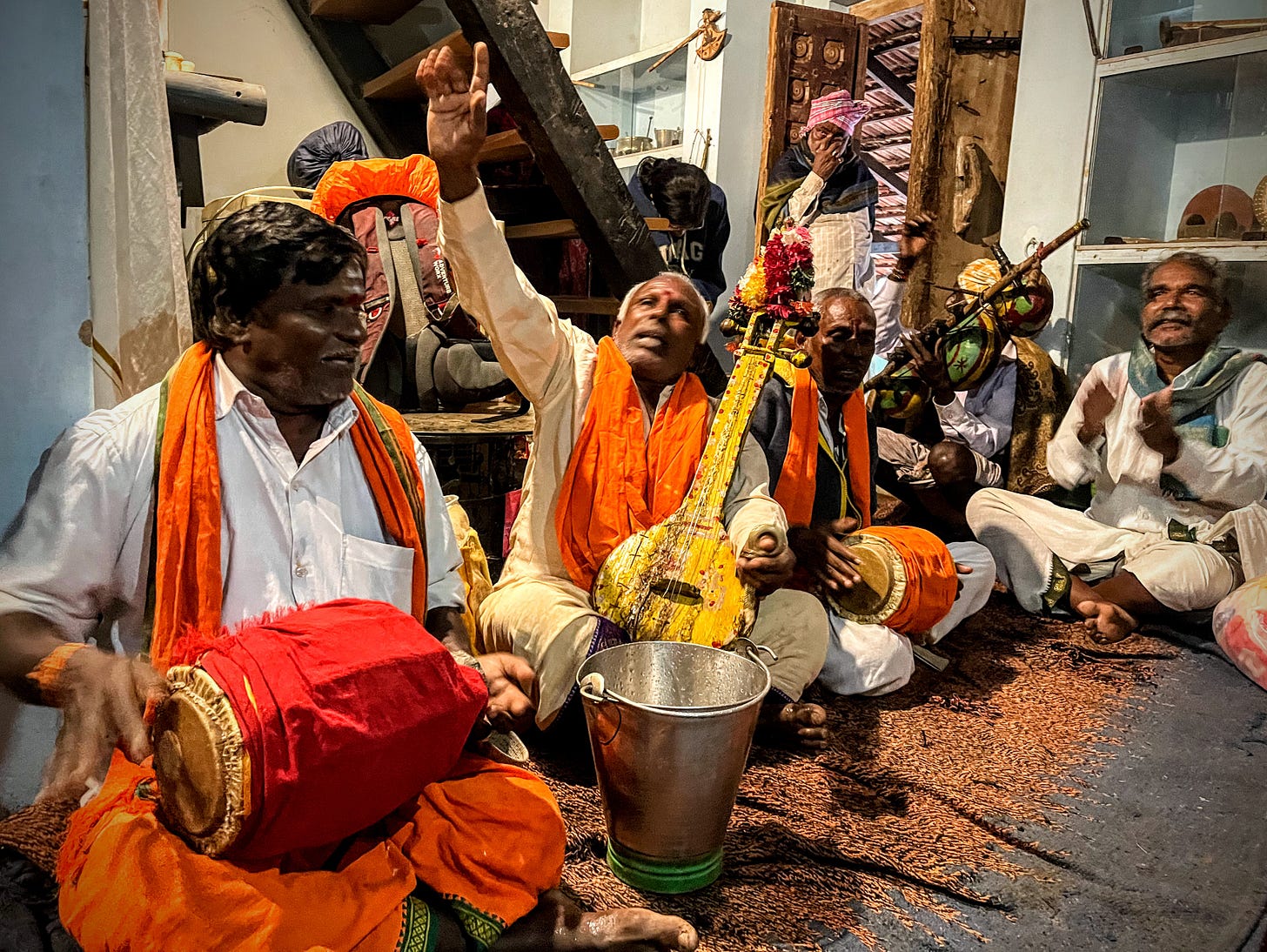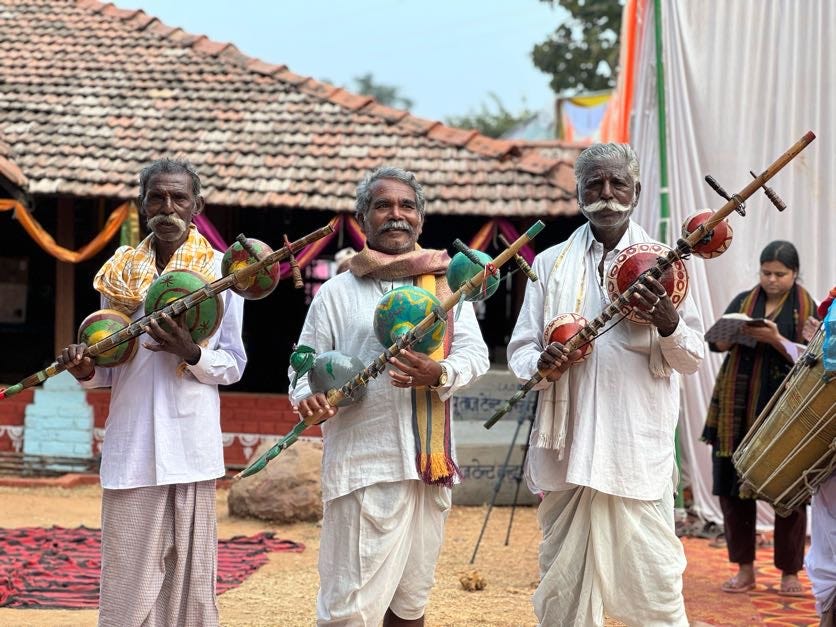The evening sky was still heavy with clouds. The rain had just stopped after pouring continuously for over ten hours. A chilly December breeze was blowing swiftly. About sixty people were huddled in a circle under a thatched hut, with the warm light of a few bulbs keeping the darkness at bay. All eyes and ears were focused on seventy year old Balaram ji of the Pradhan community, a sub-clan group of Gonds. He was accompanied by Chandrakali ji and Saraswati ji. They had come from the village of Patangarh in the neighbouring district of Dindori, Madhya Pradesh.
“We are storytellers and musicians. We sing for our Jajmans (patrons) who are Gonds. Our singing can go on for a few nights at a stretch. We always begin with a song in the praise of God”, he tells his listeners. Pradhans are musicians and bards who sing oral histories, folktales and mythological tales of the Gond community. Their performances include epic songs that recount the origins of the earth, hills, rivers, and stories of the Gond clans. They travel from village to village stopping at the homes of their patrons where they perform their music.
Balaram ji proceeded to pick up his Bana, a three-stringed fiddle which accompanies their singing. He says with pride that his bana is more than a hundred years old and was hand-crafted by his grandfather. The frame is made from the wood of khamar. Stretched over that frame is a membrane made from the inner abdomen of the cow, a very delicate part which can easily tear apart, so the instrument has to be made with dexterity and handled with delicateness. Its strings are made of horsehair. The bow is too, and is lined with little brass ghungroos.
“The air is chilly, the bana has to be heated for its sur to be melodious.” A few burning coals were brought. He quietly warmed up his bana over the red hot coals and then began his song.
India has had many traditions of knowledge. In some of these traditions, the knowledge bearers of society do not enclose themselves in walls away from the world. In contrast to the other-worldliness of the modern institutions, these worldly scholars live among the people and with the rhythms of nature. They take their shelter in the households of the farmers and the artisans, they are patronised by the village, the community, the tribe. They move along rivers, dwell by forests and trail the mountains, gathering for their conferences at the sangams and the great pilgrimage sites found in the hearts of the forests and on the heights of the hills.
Being accountable to the ordinary village dweller, they are drawn to not only make their language simple and easily understandable but to present their knowledge as poetry, song, dance, medicine and magic. They accept their remuneration in the form of wealth that their patron is abundantly endowed with. Their economy is the economy of bhiksha, a tradition once extolled by the Buddha. For this reason, those engaged in this way of life were referred to by the late artist-sculptor-philosopher Ravindra Sharma as the ‘Bhikshavritti Samaj’, which consisted of thousands of communities in the Indian subcontinent.
A gathering of these scholar-artist-bards took place during the Bhikshavritti Utsav at Jeevika Ashram near Jabalpur in Madhya Pradesh from 27th to 29th December. The Ashram is located at the foot of a hill near the Hiran river, on the outskirts of Indrana, a village of some ten thousand people. Founded by Ashish and Ragini Gupta with the blessings of the late Ravindra Sharma, the Ashram is meant to be a place of learning embedded in rural society in close proximity to the forest. Visiting the mela-sangoshthi were more than 80 artists from Telangana, Maharashtra, Rajasthan, Bengal and Madhya Pradesh. A number of senior scholars and researchers were also present.
Pradhans were one of the twenty-one communities who came to represent their artistic-intellectual traditions at the Utsav. Also present were their Telangana counterparts, the Thotis, who also sing the Gond Gatha and carry an instrument almost identical to the Bana, called Keekri. There were Baindla, Runja Kathollu, Veeranallu, Burra Kathalollu, Jamadikalu, Dubbu and Kinnera— sacred storytellers, bards, musicians, and genealogists from different regions of Telangana. There were Langas and Raos from Rajasthan, Bahuroopiyas and Nath Panthi Jogis from Maharashtra, Patchitra Katha Vachaks from West Bengal, Duldul Ghodhi and Sher Nritya from Madhya Pradesh, and a number of others.
Each community is a bearer of their own uniquely hand-crafted instruments, dialects, clothing, jewellery, tattoos, singing styles, beats and rhythms, and perhaps most importantly encompassing all of this, they are bearers of diverse knowledges. Knowledge of their surroundings and seasons, of collective memory, of properties of natural materials, of ethical dealings with community and nature, of the importance of the spiritual path and the spirit of letting go and renunciation.
Mornings at the Utsav began with the songs of the Vasudevas. Dressed in bright red clothes, an idol of Krishna adorned their heads. Equipped with a sarangi, khartals and manjiras, they sang bhajans on the essentials of a good life. The Vasudevas, for centuries, have been going from village to village early in the morning before the sun rises to sing their songs as a wake up call for villagers. The Vasudevas were just one of the wandering musicians that visited Indian villages. For instance in Telangana, a series of musician communities like Badbokulollu, Balsantholu, Jangam and Haridas visited villages at different times of the morning, thus giving a musical start to the day. They were followed by performers such as the Nats (tight-rope walkers/gymnasts), Jadugar (magician), Bahuroopiya (impersonator), Madari and Sapera, thus making the village a culturally vibrant and joyful place.
After breakfast, the scholars gathered for intense discussion on the history and fast changing conditions of the Bhikshavritti Samaj. During the day, the Mela was in full swing. Bahuroopiyas went around dressed variously as Hanuman, as Shiva, as warriors. The Sher Nritya artists performed the lion dance, Duldul Ghodhi and Mor artists performed the horse and peacock dances. On display were the Ashram’s extensive collection of copper, brass and bronze utensils and an exhibition of more than 50 types of baskets woven by the bamboo artisan of the village. Potters of the village displayed their pottery including diyas, matkas, toys and utensils - items which they still largely do not sell but only give to their patron families who they have had a relation with for generations.
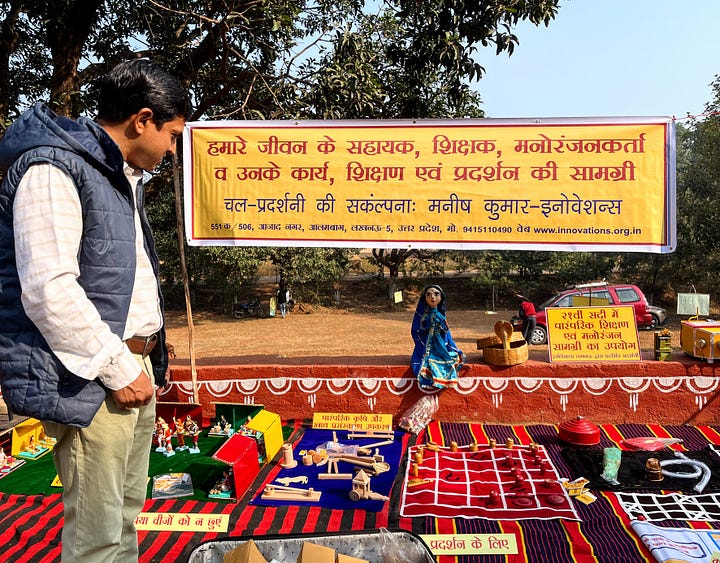


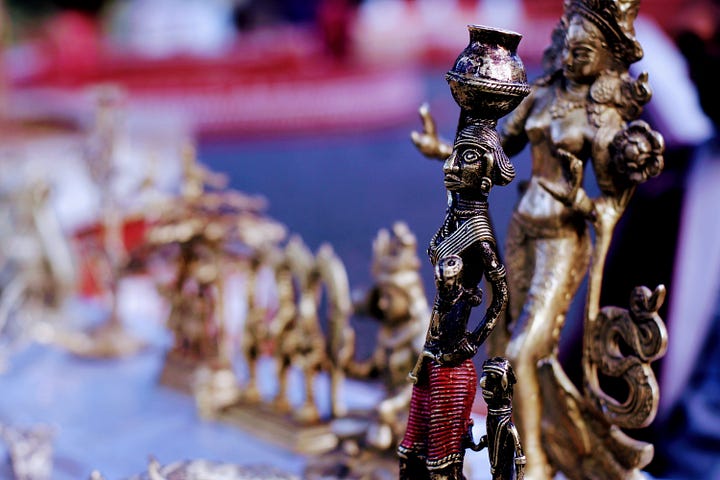
A well-known but often misunderstood example of the Bhikshavritti Samaj are the Sapera communities whose life and livelihood involve snakes. They are not merely entertainers who ‘charm’ snakes, they are important knowledge bearers and imparters. Their work has been to go from village to village, weaving story, performance, and awareness— with their tricks they drive away the fear of snakes so that people can learn to live in harmony with them in nature. They spread knowledge regarding different snake species and their identification, catch snakes and are healers with an immense repository of medicinal forest herbs and remedies for snake bites. Rather than recognise their contribution, Sapera communities today live in fear of the forest department and other modern law enforcement that has put a label of animal cruelty on them. The result is that today villages near forests are losing the knowledge of living with snakes and due to increasing fear, the number of snake killings and snake bite injuries and mortalities has been on the rise.
Starting 1871, the Sapera communities along with several other communities of the Bhikshavritti Samaj were declared as hereditary and habitual ‘criminal tribes’ by the British colonial government under the Criminal Tribes Act, a law under which even a new born child of the community was considered a criminal. After being hounded for several decades as criminals, these tribes were ‘denotified’ (thus the term, Denotified Tribes or DNT) after Independence in 1952 when the Act was repealed and was consequently replaced by the Habitual Offenders Act. However, the social attitudes that trained people, policy makers and law enforcement to look at these communities as criminals since the 19th century have not registered marked improvement since the legal and education departments continue to follow colonial patterns.
One person who has worked on the issues of the denotified tribes is Ganesh Devy, who set up the DNT Rights Action Group with Mahashweta Devi and the Adivasi Academy. Writing in the IIC Quarterly in 2000, he says,
“The social category generally known as the Denotified and Nomadic tribes of India covers a population approximately of six crores. Some of them are included in the list of Scheduled Castes, some others in the Schedule of Tribes, and quite a few in Other Backward Classes. But there are many of these tribes which find a place in none of the above. What is common to all these denotified and nomadic tribes (DNTs) is the fate of their being branded as 'born' criminals.
The story of the denotified and nomadic tribes goes back to the early years of colonial rule. In those times, whoever opposed British colonial expansion was perceived as a potential criminal. Particularly, if any attempts were made to oppose the government by the use of arms, the charge of criminality was a certainty. Many of the wandering minstrels, fakirs, petty traders, rustic transporters and disbanded groups of soldiers were included by the British in their list of criminal groups.
During the first half of the 19th century, the tribes in the North West Frontier had been declared 'criminal tribes. This category became increasingly open-ended, and by 1871 the British had prepared an official list of Criminal Tribes. An act to regulate criminal tribes was passed in that year. For instance, the Bhils who had fought the British rule in Khandesh on the banks of the Narmada and were convicted under section 110 of the IPC, were to be recognised as criminal tribals.
The Criminal Tribes Act made provisions for establishing reformatory settlements, where the criminal tribals could be kept in confinement and subjected to low paid work. They were required to report to the guard rooms several times every day, so that they did not escape the oppressive settlements.
By 1921, the Criminal Tribes Act had been extended to cover numerous other tribes in the Madras Presidency, Hyderabad and Mysore. Thus, about the time that Indian politics saw the emergence of Mahatma Gandhi as the leader of the freedom struggle, Indian society mutely witnessed the emergence of a new class of people branded as born criminals.
Soon after independence, the communities notified as criminal tribals were denotified by the Government of India. This notification was followed by the substitution of a series of Acts, generally entitled the 'Habitual Offenders Act' (the HOA). The HOA preserved most of the provisions of the former Criminal Tribes Act (CT), except the premise implicit in it that an entire community can be 'born' as criminals. Apparently, the denotification and the passing of the HOAs should have ended the misery of the communities penalised under the CT Act. But this has not happened. The police forces as well as people in general were taught to look upon the 'criminal tribes' as born criminals during colonial times. That attitude continues to persist even today.”
At the mela were a number of traditional healers. Sanjeev Vibhute of the Bhil community from Maharashtra sat with us one evening explaining the simple cures to common ailments that many people in rural areas simply live with because the modern medical system prices the treatments out of their range. From first aid to sophisticated therapies for arthritis, paralysis, and kidney stones he narrated his methods of medicine preparation and lines of treatment. He said that the Bhils might not know how to read the letters on a piece of paper but they know how to read the forest and find hundreds of herbs and medicinal plants to treat illnesses.
Another healer at the Utsav was Chamar Singh Maravi, a traditional Godna Tattooist from Dindori. The Godna tattoo artists are patronised by the Baiga community who live in the MP-Chhattisgarh-UP region. The tattoo ink used by this community is prepared by burning various medicinal herbs, and can even treat a number of health conditions. On a walk in the nearby forest, Chamar Singh ji was asked to show which herbs he knew to use for his remedies. In a span of just a few meters, he was able to identify more than twenty and explain their use cases and preparation methods.
The artists of this tradition have not simply been entertainers and knowledge bearers. They have also been shamans-counsellers-therapists who took on the role of lifting low spirits and mental healing. The Masaan Jogi, who regaled the audience at the Mela with magic trick after magic trick resides in the shamshaan bhoomi where his community has an every day interaction with the dead and those in mourning. Here in the shamshaan, the Jogi facilitates the cremation rituals and helps the family of the deceased in fulfilling their dharma towards the departed.
On the second day of the festival, dark clouds brought heavy showers which drenched the tented accommodations and personal belongings of the participants. Some hundred people huddled together in the shivering wet cold under the roof of the Crafts Museum of the Ashram. Not to be bogged down, and despite the water getting into their instruments, the Langa Musicians regaled the refugees with song after enchanting song from the sands of the Thar. In no time, others joined, transcending the differences of geography, language, religion and caste. Those present witnessed many spontaneous jugalbandis— the muslim Langas played the harmonium and khartals over the tunes of which Telugu Thoti women sang Ram bhajans. Grey clouds thundered outside and it poured non-stop. To the formal attendee it might have seemed that the ‘official’ program had come to a halt, but inside the museum, singing continued into the evening, and though the roof leaked the veenas and sarangis kept the spirit alive with their melodies.
These artists of the Bhikshavritti Samaj who added so much colour, wisdom and spirit to our lives have lived on the Bhiksha of the Indian samaaj, without consideration for accumulating their own wealth. Unlike the modern practice of bheekh, in the tradition of Bhiksha, the giver is in a position of gratitude for having the honor to offer the bhiksha and the receiver is in the position of blessing the giver. The Bhikshavritti Samaaj has been a demonstration that life can be lived richly without enterprise or employment. By giving an opportunity to the larger samaaj to practice the art of giving, they have cultivated in the samaaj the ethic of living life not just for one’s own self or one's own family but for all of society and all of creation. Through the example of their own lives, they have been inculcating in society the art of giving, the art of surrender and the art of renunciation. Thus they have been the essential connectors of the economy of cooperation or the sahyog ki arthvyavastha.
Living on bhiksha meant that these artist-scholars were not dependent on kings and big traders for their livelihood. Having their direct relationship with society, they were patronised collectively by society. The society, recognising the value of these people, guaranteed their sustenance and ensured their well being. Thus the artists were freed from the worry of earning a living and could devote themselves fully to their art. It is on the basis of such a social economy that famous artist communities such as the Bauls of Bengal and the Manganiyars of Rajasthan have emerged.
Most often, the focus of the government, NGOs and intellectuals has been on empowering these communities by making them recipients of knowledge. At the Bhikshavritti Utsav, the effort was to learn from the scholar-bard-artists of the Bhikshavritti Samaj, restoring them to their position of teachers.
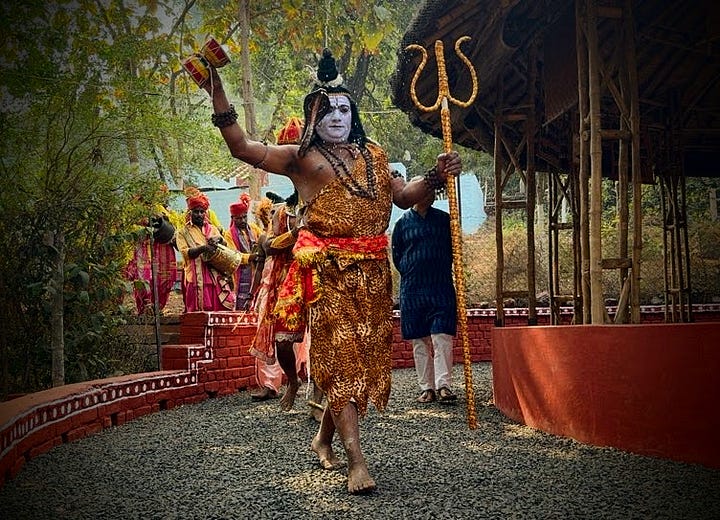
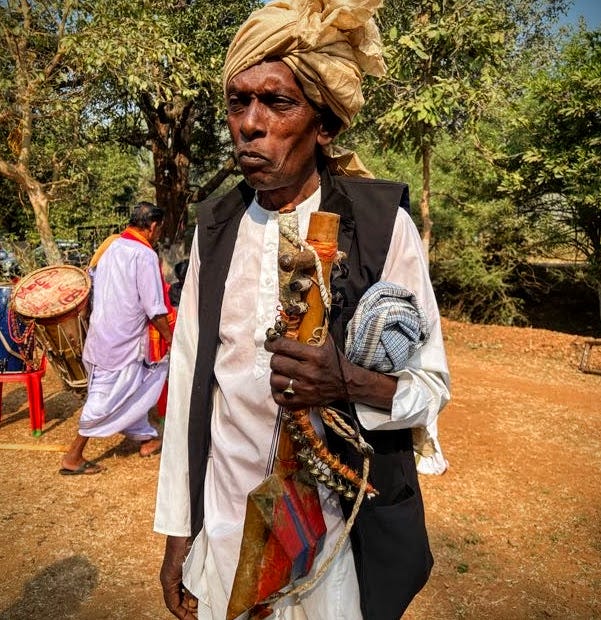
“When I left, I realised I had experienced something truly rare -- a glimpse into our cultural history, a blend of civilisational pride with a deep sense of co-dependence. I had read about Bhikshavritti, but this was an opportunity to witness its remnants in person. It left me with so much to reflect on and a deep sense of gratitude toward the individuals whose families and communities, for generations, have dedicated themselves to awakening others, selflessly teaching them about our culture and history and sharing the invaluable lessons and teachings of Gods and saints.
The experience taught me how collaboration and co-existence runs in our blood. On a rainy, grey morning, sitting with all the community members and artists together, it felt surreal to simply listen to those gems of wisdom, transcending the boundaries of statehood, caste, class, religion and language. Rajasthani Muslim singers played the harmonium while Telugu Hindu women sang a Bhajan of Ram and all the other members who did not understand the language simply clapped and enjoyed. I will cherish these moments forever.”
— Unnati Sharma, Singer and Journalist, Delhi
“When things that are long taken for granted are under threat, we are understandably slow to respond. We lack the vocabulary to notice them simply because we have never needed to speak of them. Things like our natural and cultural heritage – they have long been the context of all our speech and activity, and as such, were safely ignored. But now, that context itself is changing, silently changing what we value. Thus, it has become very difficult to keep track of what is being lost and at what cost. As more and more of our natural and cultural heritage is packaged, marketed, and laid to waste, it takes real insight to see and name the problem and point to a possible solution.
The Bhikshavritti Utsav gave me an opportunity to meet and converse with holders of some of the old traditions, people who have still not been divorced from their cultures. Although the gap between us sometimes felt huge, there were precious moments of connection and understanding. After all, this kind of relationship necessarily develops only over a long time. By recognising the value of cultivating such relationships with tradition-holders of our rich cultural heritage, the Utsav gave me an opportunity to imagine a different future than the one I generally envision, living in the modern world today.”
— Mitul Verma, Flutist and Mathematician, Ludhiana
We are grateful to our patrons whose support makes this work possible. If you would also like to help us continue our work, please reach out to us at pagdandi.collective@gmail.com. To send a contribution, please use the UPI number 93105 45026 (please mention ‘for pagdandi’) or get in touch for bank details.


